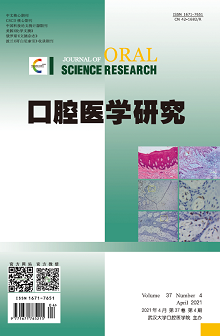|
|
Expression and Significance of MMP-9, COX-2, and NF-κB in Oral Squamous Cell Carcinoma
ZHANG Xu, LIU Jiawen
2021, 37(4):
360-365.
DOI: 10.13701/j.cnki.kqyxyj.2021.04.018
Objective: To explore the expression and significance of MMP-9, COX-2, and NF-κB in oral squamous cell carcinoma (OSCC) tissues. Methods: qRT-PCR, western blot, and immunohistochemistry were used to detect the expression levels in 80 cases of OSCC tissues. Correlation of MMP-9, COX-2, and NF-κB in OSCC tissues was analyzed using the Pearson method. OSCC patients were followed for 3 years, Kaplan-Meier was used to analyze the survival, and Log-Rank method was used to detect the survival differences between groups. COX regression analysis was used to detect the risk factors affecting the prognosis of patients. Results: Compared with the normal group, the levels of MMP-9, COX-2, NF-κB mRNA and protein in OSCC tissues were significantly increased (P<0.05). Compared with the normal group, the positive expressions of MMP-9, COX-2, and NF-κB proteins in the OSCC group were enhanced (P<0.05). MMP-9 was positively correlated with COX-2 (r=0.356, P=0.012) and NF-κB (r=0.312, P=0.005), and COX-2 was positively correlated with NF-κB (r=0.619, P=0.000). MMP-9, COX-2, and NF-κB were closely related to the pathological grade, degree of differentiation, lymph node metastasis, and TNM stage in OSCC patients (P<0.05). The overall survival rate of the MMP-9 negative expression group was higher than that of the positive expression group (P<0.05). The overall survival rate of the COX-2 negative expression group was higher than that of the positive expression group (P<0.05), and the overall survival rate of the NF-κB negative expression group was higher in the positive expression group (P<0.05). COX regression analysis showed that lymph node metastasis, TNM staging, MMP-9, COX-2, and NF-κB may be independent risk factors affecting the prognosis of OSCC patients (P<0.05). Conclusion: MMP-9, COX-2, and NF-κB were highly expressed in OSCC tissues. The expression levels of MMP-9, COX-2, and NF-κB were closely related to the clinicopathological parameters of patients.
References |
Related Articles |
Metrics
|

